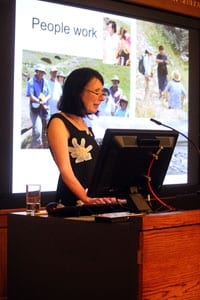How do you use your own body to understand past landscapes?
By news editor, on 15 May 2012
 Those attending Professor Sue Hamilton’s (UCL Institute of Archaeology) inaugural lecture on Tuesday 8 May at UCL were treated to a tour de force of more than two decades of archaeological fieldwork engaging with the artefacts, sites and landscapes from Bodmin Moor in Cornwall, Puglia in southern Italy to the monumental landscapes of Rapa Nui (Easter Island) in order to answer precisely that question.
Those attending Professor Sue Hamilton’s (UCL Institute of Archaeology) inaugural lecture on Tuesday 8 May at UCL were treated to a tour de force of more than two decades of archaeological fieldwork engaging with the artefacts, sites and landscapes from Bodmin Moor in Cornwall, Puglia in southern Italy to the monumental landscapes of Rapa Nui (Easter Island) in order to answer precisely that question.
Hamilton’s major influence in the field has been her unfaltering commitment to reconfiguring archaeology theory and practice as a form of ‘people work’.
At the heart of her innovative fieldwork methodology is the idea that archaeologists share something with the people whom they study – they inhabit the same landscapes and, therefore, can use their own bodies to generate multi-sensory theories about the past.
What does it feel like to walk to and from ancient sites in the landscape, what can you see and hear when inside or outside them? What can this tell us?
People-centred archaeology
On the night, Hamilton depicted her career as being a series of interrelated threads – she looked at four interconnected strands of her work: space and landscape, fieldwork, people and representation and then showed how these interlinked in a case-study of Rapa Nui.
Hamilton’s discussion of the craft of archaeology, the actual ‘work on the ground’ was interesting as it is rarely discussed in academic context, even if it is the very basis of everything we do as archaeologists.
She outlined how in fieldwork it is the body that links practice and theory, and how in her approach – ‘people-centred archaeology’ – also produces the methods to think about space.
Hamilton’s concern with connectivity is exciting – not only how we mediate between past and present peoples, different places and sites in a landscape, but also how we connect the different kinds of data with which archaeology engages, from microscopic analysis of artefacts to mapping human activity over vast tracts of time and space.
A living body
It should come as no surprise that Hamilton described her most recent fieldwork area, Rapa Nui, as a ‘living body’, a place with its own special ‘landscape integrity’.
By applying a body-centred approach, the AHRC funded project Rapa Nui Landscapes of Construction is asking new questions of one of the world’s most famous archaeological landscapes – rethinking where and how the iconic statutes (moai) look, where they travelled to and from and how they connect with other lesser known sites such as the canoe houses (hare paenga), and what this might imply about Rapa Nui cosmology and perceptions of land and sea.
Speakers on the night described Hamilton’s Rapa Nui work as a ‘jump’, a brave leap into a new field area. Her work on Pacific island archaeology may be better conceptualised as a side-step in which she is bringing to the Pacific a much needed reflexive approach to fieldwork.
Pacific archaeology is, on the whole, driven by a concern with grand narratives of island colonisation, theories of social structure and the like; so much so that the human story, the close interaction between people and place is often lost.
Hamilton’s fieldwork approaches are actually all the more pertinent in a Pacific island context where most local people continue to express an affinity with their ancestral sites and objects – these are most definitely ‘living landscapes’.
The event, which was the last in a series of inaugural lectures to mark the 75th anniversary of the UCL Institute of Archaeology, was very well attended, by present staff and students of the Institute as well as former colleagues of Sue and collaborators from other British universities.
Further details of all activities being held throughout the anniversary year are available on the Institute’s website: http://www.ucl.ac.uk/archaeology/about/75th_anniversary
Review by Sarah Byrne, UCL Mellon Postdoctoral Research Fellow (http://www.ucl.ac.uk/archaeology/people/staff/byrne) and Ulrike Sommer, Senior Lecturer in Prehistoric Archaeology, UCL Institute of Archaeology (http://www.ucl.ac.uk/archaeology/people/staff/sommer)
 Close
Close

